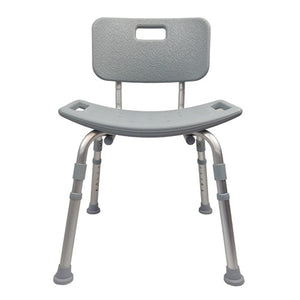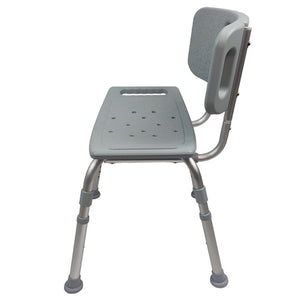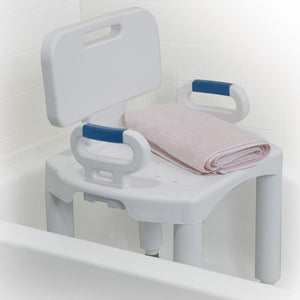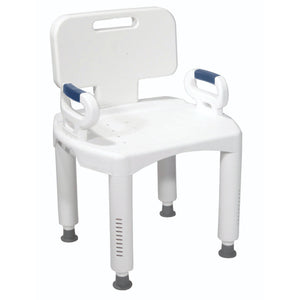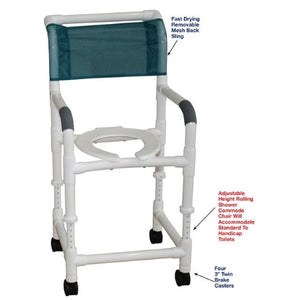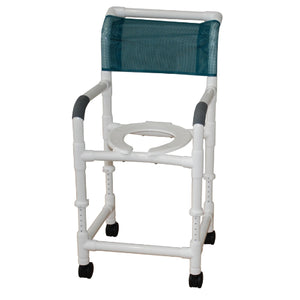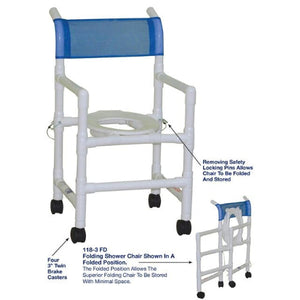Wondering how to use a shower chair? It's easier than you think. This guide will show you the steps. You'll gain confidence and safety in your daily routine. Let's start!
What Is a Shower Chair?
Shower, bath, or shower seats are all the same. They are an invaluable aid for people who find it challenging to remain standing throughout their shower duration. Elderly and disabled individuals find them particularly useful.
They have four legs, each capped with rubber which makes them safer. This stops the chair from sliding around in a wet, slippery tub.
The material is key too. Shower chairs usually consist of plastic and aluminum. Why? These materials don't rust and can withstand the wet conditions in a bathroom.
5 Different Types of Shower Chairs:
1. Standard Shower Chairs:
A standard shower chair is a popular choice for older people. It's comfortable and safe, with a spacious seat, back support, and hand grips.
One can adjust the height to meet individual needs, making it an excellent option for various users. The rubberized feet add stability, reducing the risk of slips and fall.
2. Folding Stool Chairs:
These are simpler than standard chairs but offer their own set of advantages. These chairs are more affordable and have curved seats for comfort.
While they lack a backrest, they still provide a secure grip. Their design lets you fold them up for easy storage or to clear some space when you're not using them.
3. Rolling Shower Chairs:
They are ideal for seniors prone to slips and falls. Rolling shower chairs resemble wheelchairs with wheels that lock, a backrest, armrests, and cushioned seat. This type of chair provides extra safety and comfort.
4. Fold-Down Shower Chairs:
You can permanently attach it to the shower wall. Fold-down shower chairs offer a fixed seating solution with back support, armrests, and a spacious seat. While these chairs are less adjustable than others, they provide excellent stability.
5. Transfer Benches:
When considering "tub bench vs shower chair," it's important to know that both are fantastic tools. They assist older adults in quickly getting into and out of the shower.
They come in sliding and non-sliding options. Sliding benches allow seniors to glide from the edge of the tub right onto their shower chairs.
Non-sliding benches with a backrest need more physical strength. But they still provide a safer method of entering and exiting the shower.
6 Safety Steps to Use a Shower Chair:
Step 1: Position the Chair:
Start by placing the shower chair in the bathtub or shower stall. The focus here is stability. Ensure all four rubberized feet are touching the tub or shower floor evenly. There should be no risk of wiggling, slipping, or tilting. If the chair feels unstable, reposition it.
Step 2: Double Check Stability:
For extra security, consider placing a slip-resistant mat underneath the chair. This reduces the chance of the chair tipping over. The mat should be flat and fully waterproof to avoid bunching up when wet, which could create a tripping hazard.
Step 3: Clear the Area:
Next, clear any potential hazards from your shower stall or bathtub. This could be a soap dish that might fall or a shower caddy that could tumble. Keeping the area free from obstructions makes maneuvering more manageable and safer.
Step 4: Adjust the Chair Height:
The shower chair must be at the correct height for the user. Most chairs come with adjustable legs. So set the height to a level where the user's feet can touch the floor entirely.
But ensure it is high enough that standing up becomes easy. The perfect height allows users to place their feet flat on the floor.
Step 5: Arrange Shower Essentials:
Before getting into the shower chair, ensure all necessary items for bathing are within arm's reach. This includes soap, shampoo, conditioner, washcloths, and anything else needed.
Having everything close by helps avoid unnecessary movements that could lead to slips or falls when seated on the chair.
Step 6: Sit Correctly:
Once you position and adjust the chair correctly, it's time to start bathing. The user should always sit in the center of the chair to prevent slipping off the edge. The soap and water can make the chair's surface slick.
What To Consider Before Buying a Shower Chair?
Choosing the correct type of shower chair depends on individual needs and circumstances. It's essential to consider the user's mobility levels, physical strength, and preferences for shower chair training.
Some other factors are:
- Cost: Not covered by Medicare or Medicaid, the cost of a shower chair falls on the user. Prices vary, so compare a few before deciding. Remember, cheaper is only sometimes better.
- Ease of Use: The chair should be easy to use. If a senior struggles with it, they won't use it, regardless of cost.
- Comfort: Manufacturers typically make shower chairs from plastic and metal. However, comfort levels can vary significantly. Look for adjustable features for a custom fit.
- Portability: A portable chair is best for a busy household. It should have a backrest and slots in the seat for safe gripping when sitting or standing.
Conclusion
Understanding how to use a shower chair can significantly enhance safety for older adults or those with mobility issues. Additionally, it provides considerable comfort during their bathing routines.
Ready to make your life even easier? Check out MoovKart for various practical solutions designed to assist in everyday tasks. Make your move with MoovKart today!
FAQs:
Is it safe to use a shower chair in a fiberglass tub?
No, we don’t recommend using a shower chair in a fiberglass tub due to potential damage and safety issues. The legs of the chair will damage the glass. You can attach wooden runners with the chair legs.
How do you properly use a shower curtain with a tub transfer bench?
Tub transfer benches usually come with a slit where the shower curtain can fit. In this way, you can use the curtain while on the bench.
What's the better alternative to a shower chair?
A raised toilet seat or shower stools could be viable alternatives.
How should one use a shower chair after knee replacement surgery?
Use a sturdy chair with a backrest and armrest or lean against the wall for support. Ensure all shower items are within arm's reach and install grab bars to assist in standing and sitting.
Use an anti-slip mat to avoid falling. Wrapping your wound dressing is also helpful to keep it dry during the shower.


